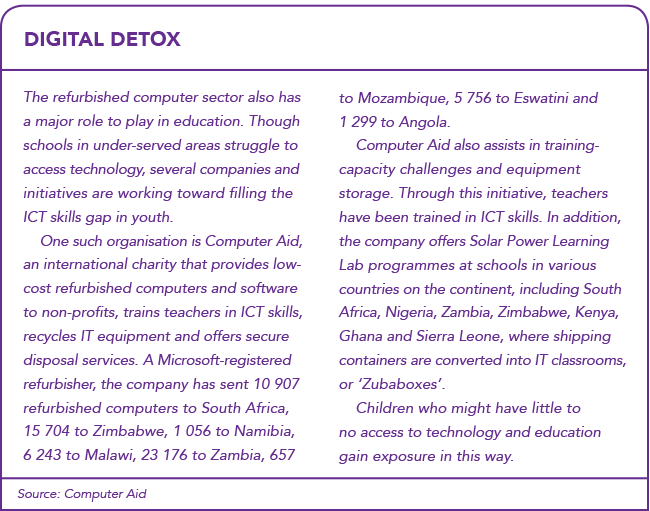When the Johannesburg Stock Exchange-listed Discovery Group – one of South Africa’s biggest private healthcare companies – needed 4 000 computers in 2015, it didn’t buy new models. Instead, it saved ZAR14 million by getting refurbished second-hand equipment.
For many businesses, the refurbished market has become increasingly attractive when looking for IT equipment – especially for smaller companies – as it enables them to access vital services without draining valuable resources. ‘The sector has a positive impact on SMEs, which are usually cash flow strapped,’ says Wale Arewa, CEO of Randburg-based IT asset management firm Xperien. ‘The release of cash flow allows the company to invest in other areas of the business and they don’t have to worry about getting loans for IT equipment. These factors give them a greater chance of success.’
With the cost of components in the second-hand computer market starting at between ZAR2 500 and ZAR3 000, for many businesses, that can translate into big savings. According to Arewa, companies can save up to 70% in costs by choosing to purchase refurbished equipment. Buying the ‘latest and greatest’ technologies is not necessary – unless there’s a real need for high-powered applications, he says, pointing out that in most businesses the majority of employees need only basic computing facilities. A slightly older version of a laptop can often work just as well and process the same data, meeting the needs of the employee.
Qrent, the company that supplied Discovery with refurbished computers, has also created tailor-made solutions for the SME sector, says CEO DJ Kumbula. ‘This means the same benefits that we are giving to big business, such as deep cost savings and access to Tier 1 equipment at a fraction of the cost, with funding and warranties, are now available to small businesses, which typically struggle to access solutions such as these. Companies pay far less for the same equipment as new.’
Refurbished doesn’t just mean second-hand, though. It includes new demo units, minor defects on machines, ‘dead-on-arrivals’ and machines with exterior shipping damage. The refurbishing process is not merely the cleaning and repackaging of devices either. At Xperien, for example, it is ‘an intensive process that includes replacing faulty components, manufacturer OEM burn-in testing, cosmetic surgery, quality control, performance upgrading, software and firmware redeployment and packaging.
Integrity tests are also run on each critical component to ensure the highest standard and functionality’, says Xperien senior business development manager Bridgette Vermaak. According to Arewa, ‘IT equipment is designed to last around three years, while refurbishing extends the life of this equipment to around 10 years by upgrading the performance and removing manufacturers’ obsolescence’.
There are several options available for businesses looking to acquire refurbished machines. The first is via a buy-back system, or ‘IT asset disposition’, which involves the collection of end-of-life equipment from businesses, a data wipe, repairs, hardware replacements and reassembly; followed by testing, quality control and cosmetic repairs, software installations and licensing. At one company, Xperien bought back old laptops that were supplied three years earlier for 15% residual value. Arewa says the buy-back model is still new in SA. ‘Larger companies are starting to realise the benefits, which also include data destruction, reverse logistics and end-of-life reporting.’
An increasingly popular way to acquire equipment is to lease it. According to Kumbula, ‘Finance 101 says “you buy assets that appreciate; you rent assets that depreciate and need regular replacement”. The bottom line is, leasing is cheaper than paying [upfront]. It provides cash flow smoothing, you match the expense to the useful life of the asset, and it facilitates a disciplined technology refresh cycle. Value is eroded when companies buy depreciating assets. And the risk is transferred to Qrent as the client gets the asset today, but pays for it later over a number of years.’
As rentals are 100% tax deductible, the benefits of leasing assets extend beyond the flexibility of repayment options, which can be either monthly or quarterly in structure, according to Vermaak. ‘An operating lease is purely off balance-sheet funding where there is no depreciation to write off, and the interest is calculated on the capital amount, excluding VAT,’ she says. ‘By the end of the lease period you do not own the asset, and you will only have paid for the use thereof.’ However, Vermaak adds, at the end of each lease period, clients are given the option to purchase the equipment at a reduced rate to further extend the life cycle.
On an international level, technology giant Microsoft implemented its Registered Refurbisher Programme for refurbishers to resell computers and laptops with genuine software at an affordable price. According to the company’s website, the programme is aimed at small and mid-sized refurbishers across the globe who want to supply refurbished PCs pre-installed with genuine Microsoft software to local consumers and businesses, as well as qualified charitable organisations, academic users and specially approved recipients. This enables SMEs to acquire legal and up-to-date software on refurbished models without having to worry about copyright law. Members of the programme must ‘follow strict requirements established by Microsoft to ensure customers receive a high-quality, professional refurbished device installed with genuine Microsoft Windows’. Both Qrent and Xperien are registered Microsoft refurbishers, along with 21 other South African companies. ‘Non-compliance is not an option,’ according to Kumbula.
For most companies, data security is a major consideration when it comes to the disposal of computer assets. For example, sensitive internal information can be left on hard drives. And it’s not only business secrets that can be exposed – data compiled about customers could also be accessed. In South Africa, the Protection of Personal Information Act protects personal information, and companies are obliged to take steps to keep this safeguarded. Vermaak says there are two methods to wipe computers clean – ‘digital sanitisation’ (a software-based method), and ‘degaussing’, which uses magnetisation to neutralise the data and hard drive mechanism.
‘Each erasure is verified and certified, resulting in a tamper-proof certificate of erasure to prove compliance with local, national and global data protection regulations,’ she says.Xperien has adopted a standard called Certified Refurbished System, ensuring refurbished systems are ISO certified and audited. ISO is a global standard developed for companies to incorporate environmental methodologies into operations and product guidelines.
As well as cost considerations, another aspect driving interest in refurbished equipment is the growing concern over e-waste. The Mail & Guardian reports that the Department of Environmental Affairs, Forestry and Fisheries estimates South Africa generates 360 000 tons of e-waste annually. Various laws, such as the National Environmental Waste Management Act 2008 and the Consumer Protection Act 68 of 2008 regulate the disposal of e-waste, which, according to ITWeb, involves knowing how to ‘isolate and dispose of the toxic components and heavy metals such as beryllium and lead’ during recycling. ‘There’s no doubt that by using refurbished equipment you are extending the life of electronic equipment which may otherwise end up in a dump somewhere, harming the environment,’ says Kumbula.
Arewa adds that refurbishing is crucial to creating a viable circular economy. ‘The life of existing equipment is prolonged. This means less equipment is required for industry, [thus] less equipment is recycled annually.’ Arewa sees the market experiencing the most rapid growth in developing countries. ‘Globally, the industry is worth US$250 billion annually, but locally it is barely ZAR500 million,’ he says. ‘This is less than 0.5% of the global market and it is in developing countries that refurbished equipment is needed the most, due to its low-cost options.’



